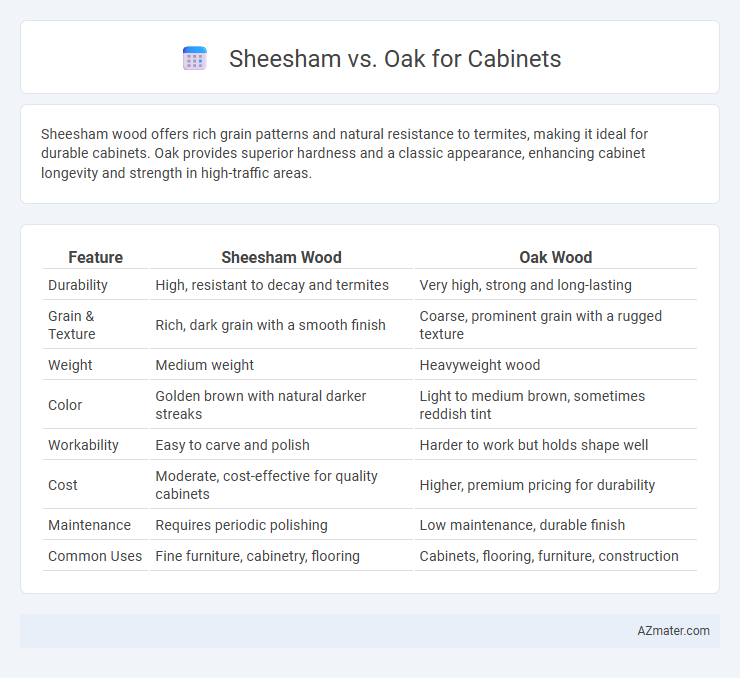Sheesham wood offers rich grain patterns and natural resistance to termites, making it ideal for durable cabinets. Oak provides superior hardness and a classic appearance, enhancing cabinet longevity and strength in high-traffic areas.
Table of Comparison
| Feature | Sheesham Wood | Oak Wood |
|---|---|---|
| Durability | High, resistant to decay and termites | Very high, strong and long-lasting |
| Grain & Texture | Rich, dark grain with a smooth finish | Coarse, prominent grain with a rugged texture |
| Weight | Medium weight | Heavyweight wood |
| Color | Golden brown with natural darker streaks | Light to medium brown, sometimes reddish tint |
| Workability | Easy to carve and polish | Harder to work but holds shape well |
| Cost | Moderate, cost-effective for quality cabinets | Higher, premium pricing for durability |
| Maintenance | Requires periodic polishing | Low maintenance, durable finish |
| Common Uses | Fine furniture, cabinetry, flooring | Cabinets, flooring, furniture, construction |
Introduction: Sheesham vs Oak Cabinets
Sheesham cabinets offer rich, dark tones with intricate grain patterns, making them a popular choice for traditional and rustic interiors. Oak cabinets, known for their durability and lighter, more uniform grain, suit a wide range of contemporary and classic designs. Choosing between Sheesham and Oak depends on factors like wood hardness, finish preferences, and budget considerations for long-lasting cabinetry.
Wood Characteristics: Sheesham and Oak
Sheesham wood, known for its rich grain patterns and natural resistance to decay, offers a warm, golden-brown hue that deepens over time, ideal for elegant cabinet finishes. Oak wood features a prominent grain with a light to medium brown color, valued for its strength, durability, and resistance to moisture and wear in cabinetry. Both woods provide excellent stability, but Sheesham's oily texture enhances natural pest resistance, while Oak's hardness ensures long-lasting structural integrity.
Appearance and Grain Patterns
Sheesham wood, known for its rich, golden-brown hues with darker streaks, showcases a natural luster that enhances cabinet aesthetics with a warm, inviting appearance. Oak features a lighter, more uniform tan to deep amber color with prominent, straight grain patterns that offer a classic, timeless look for cabinetry. The distinct grain patterns of Sheesham are typically more varied and dramatic, providing a striking visual texture compared to the more consistent and traditional grain of Oak.
Durability and Strength Comparison
Sheesham wood offers exceptional durability due to its natural oils, making it resistant to decay and termites, ideal for long-lasting cabinets. Oak is renowned for its superior strength and hardness, providing excellent structural integrity and resistance to dents, suitable for heavy-use cabinetry. Comparing both, Oak generally surpasses Sheesham in strength, while Sheesham excels in weather resistance and natural protection against pests.
Cost and Affordability
Sheesham wood offers a more affordable option for cabinet making compared to oak, with prices typically ranging from $25 to $50 per board foot, whereas oak generally costs between $35 and $60 per board foot. The cost-effectiveness of Sheesham is enhanced by its durability and resistance to termites, making it a budget-friendly choice for long-lasting cabinets. Oak, while more expensive, delivers a premium finish and greater hardness, which can increase upfront costs but may reduce maintenance expenses over time.
Maintenance Requirements
Sheesham wood requires regular oiling to maintain its natural luster and prevent drying or cracking, making its upkeep moderately demanding. Oak cabinets need less frequent maintenance due to their dense grain, which resists dents and scratches while only requiring occasional polishing to retain shine. Both woods benefit from avoiding excessive moisture and direct sunlight to prolong their cabinet lifespan.
Environmental Impact and Sustainability
Sheesham wood, harvested from the Dalbergia tree native to India, is often considered more sustainable due to its faster growth rate and renewable harvesting practices compared to Oak, which comes from slower-growing temperate forests. Oak, while durable and long-lasting, tends to have a higher environmental footprint because deforestation in oak forests can lead to habitat loss and requires lengthy regrowth periods. Both woods should be sourced from certified sustainable plantations or reclaimed materials to minimize environmental impact in cabinet manufacturing.
Best Uses in Cabinet Design
Sheesham wood offers rich grain patterns and natural oils that make it highly durable and resistant to termites, ideal for handcrafted, intricate cabinet designs in dry climates. Oak provides a strong, dense grain with excellent shock resistance, making it perfect for modern, heavy-use cabinetry requiring longevity and a classic look. Both woods excel in cabinetry, but Sheesham suits artisanal, decorative pieces while Oak is best for robust, functional kitchen and storage cabinets.
Pros and Cons of Sheesham Cabinets
Sheesham cabinets offer rich natural grain patterns and durability due to their dense hardwood composition, making them resistant to warping and ideal for long-term use. They are more affordable compared to oak but require regular maintenance to prevent dryness and cracking. On the downside, sheesham wood can be heavier and less uniform in color than oak, which may affect aesthetic consistency in cabinetry.
Pros and Cons of Oak Cabinets
Oak cabinets offer exceptional durability and a classic, timeless appearance with prominent grain patterns that enhance kitchen aesthetics. They resist scratches and dents effectively but can be prone to yellowing over time and may require regular maintenance to preserve their finish. Oak's heavier weight compared to Sheesham can make installation more challenging while providing superior strength and longevity.

Infographic: Sheesham vs Oak for Cabinet
 azmater.com
azmater.com